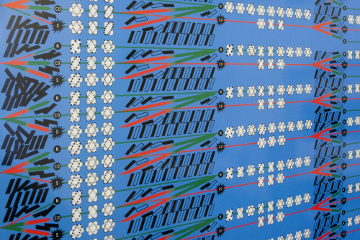- CA2M MUSEUM
- exhibitions
- CÁPSULA DE COLECCIÓN: LAWRENCE ABU HAMDAN (CONFLICTED PHONEMES)
CÁPSULA DE COLECCIÓN: LAWRENCE ABU HAMDAN (CONFLICTED PHONEMES)

Lawrence Abu Hamdan (Amman, Jordan, 1983) is one of the most important artists of his generation on the international scene, nominated this 2019 for the Turner Prize, the most prestigious award in British art.
Conflicted Phonemes was produced by the “CASCO Art Institute. Working for the Commons” in Utrecht. Adhering to this institution’s customary modality of group production and workshops, Lawrence Abu Hamdan convened a two-day encounter to discuss a controversial topic: the phonetic policies that govern the acceptance or rejection of asylum applications by migrants in different European countries. The group consisted of twelve Somalian citizens – who had been subjected to an analysis of language and accent by the Dutch system of migratory control and whose applications had been rejected – as well as linguists, researchers, activists, cultural organizations, as well as the graphic designer Janna Ulrich.
The diagrams made by the latter as the result of this encounter are the responses to the unilateral outcome of the rejection of asylum: they offer a silent protest, purely visual, to the identitary reification that their voices have suffered. The diagram’s density reflects the complex task of recording in these voices the biographies of hunger and conflict, of the necessary adaptation of the capacities of oral communication during the long migratory journeys, of the vital obligation of hybridization and contamination during years in overcrowded refugee camps along the path of their destines. The maps demonstrate the impossibility of fixing in one sole place this concoction of voices.
At a moment when neoliberal European democracies clamor for the necessity of listening to the voices of those migrants and create means for them to speak to the rest of the social group, forensic linguistics distinguishes these syllables as a mode of designating citizenship beyond the national identity card. These diagrams allow us to rethink how borders are made perceptible in configurations of vowels and consonants transformed into a legal responsibility that the artist attempts to make complex and to dismantle. As he explains: “Isn’t it more logical that the accent of a legitimate asylum seeker would be an irregular hybridization of voices, the biography of a journey, more than the pure voice that claims a firm attachment to its roots in one single place?.”
This work belongs to a larger research project, Aural Contract, in which Lawrence Abu Hamdan examines – via events, exhibitions, publications, and a sound archive – the contemporary politics of listening and the role of the voice in present-day legislation.
These maps have been exhibited in the various spaces of refugee organizations in Europe. But they were also were shown to a Dutch judge who forms part of the system of migratory control in that country and during a deportation hearing in a British asylum court. In addition to belonging to the Collection of the CA2M, other editions of this work are included in the collection of the MOMA in New York and in that of the Tate Modern in London.